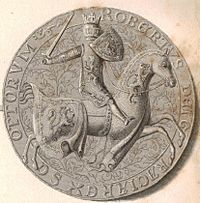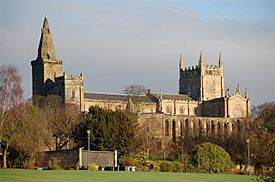Robert II of Scotland facts for kids
Quick facts for kids Robert II |
|
|---|---|
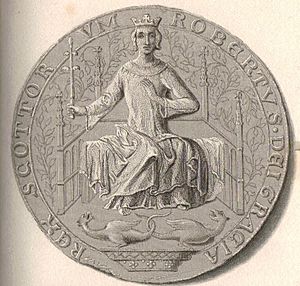
Great Seal of Robert II
|
|
| King of Scots | |
| Reign | 22 February 1371 – 19 April 1390 |
| Coronation | 26 March 1371 |
| Predecessor | David II |
| Successor | Robert III |
| Born | 2 March 1316 Paisley Abbey, Renfrewshire, Scotland |
| Died | 19 April 1390 (aged 74) Dundonald Castle, Ayrshire, Scotland |
| Burial | Scone Abbey |
| Spouse | Elizabeth Mure Euphemia de Ross |
| Issue more... |
|
| House | Stewart |
| Father | Walter Stewart, 6th High Steward of Scotland |
| Mother | Marjorie Bruce |
Robert II (born 2 March 1316 – died 19 April 1390) was the King of Scots from 1371 until he passed away in 1390. He was the son of Walter Stewart, 6th High Steward of Scotland, and Marjorie Bruce, who was the daughter of King Robert the Bruce. Robert II was the very first king from the House of Stewart. When his uncle, David II, died, Robert became king.
Robert Stewart was named the next in line to the throne after his mother, Marjorie Bruce, died in a riding accident around 1317. However, this changed when King Robert I had a son, David, in 1324. Robert Stewart became the High Steward of Scotland when his father died in 1327. That same year, Parliament agreed that Robert would be heir again if David died without children. In 1329, King Robert I died, and his five-year-old son became King David II.
Scotland faced more wars for independence. Edward Balliol, with help from England, attacked Scotland. Robert Stewart fought in some of these battles, like the one at Halidon Hill in 1333. He and King David found safety in Dumbarton Castle. David went to France in 1334, and Robert became one of the guardians of the kingdom. Robert held this role until David returned in 1341. Robert was with David at the Neville's Cross in 1346. David was captured, but Robert managed to escape. David remained a prisoner until 1357.
Robert married Elizabeth Mure around 1348, which made their four sons and five daughters legitimate. Later, he married Euphemia de Ross in 1355, and they had two sons and two daughters. Robert became king in 1371 at 55 years old. Scottish lords kept fighting English-held areas in the south. By 1384, most of these lands were back under Scottish control. Robert made sure Scotland was part of a peace agreement between England and France in 1384. This led to him losing control of the country in November. First, his oldest son, John, took over, and then from 1388, John's younger brother, Robert, took charge. Robert II died at Dundonald Castle in 1390 and was buried at Scone Abbey.
Contents
Becoming the Next King
Robert Stewart was born in 1316. He was the only child of Walter Stewart and Marjorie Bruce, King Robert I's daughter. Marjorie died shortly after Robert was born. Robert grew up like a Gaelic noble on the Stewart family lands in Bute, Clydeside, and Renfrew.
In 1315, Parliament changed the rules for who would inherit the throne. They chose Marjorie Bruce's uncle, Edward Bruce, instead of her. But Edward was killed in battle in 1318. So, Parliament quickly decided that Marjorie's son, Robert, would be the heir if the king died without another child. However, King Robert had a son, David, in 1324. This meant Robert Stewart was no longer the direct heir. But in 1326, Parliament met again and put Robert back in the line of succession. This meant he would become king if David died without an heir. To go with this, he also received lands in Argyll, Roxburghshire, and the Lothians.
High Steward of Scotland
Fighting for Independence Again
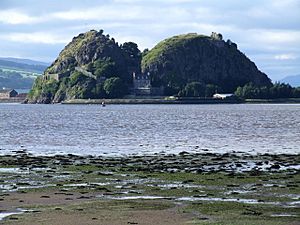
The first war for Scotland's independence started during the reign of King John Balliol. King Edward I of England kept trying to control Scotland, which caused problems for Balliol. Scottish leaders decided that war was the only way to stop the English king from weakening Scotland's power. So, they made a treaty with France in 1295 to help each other.
In 1296, the Scots attacked England. This made the English king angry, and he invaded Scotland. He captured Berwick and defeated the Scottish army at Dunbar. John Balliol gave up his throne to Edward and was sent to London as a prisoner. But Scots like William Wallace and Andrew Moray continued to fight against the English in King John Balliol's name. After they died, Robert the Bruce kept fighting. He eventually defeated the forces of Edward II of England and became the King of Scotland.
David Bruce became king on 7 June 1329, when he was only five years old, after his father Robert I died. Robert Stewart's father, Walter the Steward, had died earlier in 1327. So, the eleven-year-old Robert was put under the care of his uncle, Sir James Stewart. James, along with Thomas Randolph, 1st Earl of Moray, and William Lindsey, were appointed as joint Guardians of the kingdom.
David becoming king led to the second war of independence, which put Robert's position as heir at risk. In 1332, Edward Balliol, the son of the king who had been removed, attacked Scotland. He had quiet support from King Edward III of England and clear backing from Scottish nobles who had lost their lands under Robert I. Edward Balliol's forces heavily defeated the Bruce supporters at Dupplin Moor in 1332 and again at Halidon Hill in 1333. The 17-year-old Robert fought at Halidon Hill.
Balliol took over Robert's lands, but Robert managed to escape capture. He found safety at Dumbarton Castle, where King David was also hiding. By the winter of 1333, very few castles in Scotland were still held by the Scots.
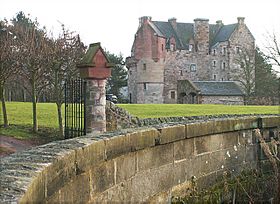
In May 1334, things looked very bad for the Bruce family, and David II went to France for safety. Robert started to win back his lands in western Scotland. The Scottish resistance to Balliol was almost collapsing in 1335. But then, Sir Andrew Moray of Bothwell appeared as a strong war leader. He was appointed Guardian during the winter of 1335–36. Moray died in 1338, and Robert took over as Guardian again.
Moray's actions stopped Edward III from fully controlling southern Scotland. Edward's failure to capture Dunbar Castle after a six-month siege confirmed this. Many of Balliol's main supporters switched to the Bruce side. Major English strongholds began to fall to the Scots. For example, Cupar fell in 1339, and Perth was taken by Scottish armies in June 1339. Edinburgh was captured by a clever plan in April 1341.
John Randolph, who had been released from English capture, visited David II in Normandy before returning to Scotland. David II did not trust Robert Stewart, even though Robert was the heir and Guardian. By June 1341, Scotland seemed stable enough for the king to return. On 17 October 1346, Robert went with David to the Neville's Cross. Many Scottish nobles died there, including Randolph. David II was wounded and captured, while Robert and Patrick, Earl of March, seemed to have left the battlefield.
King David's Time in Prison
With the king now held prisoner in England and Randolph dead, Robert became Guardian again. In 1347, he took an important step to make sure his four sons and six daughters were considered legitimate. He asked Pope Clement VI for special permission to marry Elizabeth Mure under church law.
Even though David was a prisoner, he still had some power in Scotland. Robert's Guardianship was removed by Parliament and given to other earls. But this didn't last, and Robert was appointed Guardian again in February 1352. David, who was out on parole, attended this Parliament. He presented the conditions for his release to Robert and the Scottish leaders. These conditions did not ask for ransom. Instead, they required the Scots to name the English prince John of Gaunt as the next in line to the Scottish throne. The Council rejected these terms, and Robert was against anything that threatened his right to be king.
The king had no choice but to return to prison. By 1354, talks for the king's release led to an agreement for a ransom of 90,000 marks, to be paid over nine years. But Robert ruined this agreement when he committed the Scots to help France fight England in 1355. The capture of Berwick and the French presence in England made Edward III attack the Scots. In January 1356, Edward led his forces into southeast Scotland, burning Edinburgh and Haddington. This campaign was called the 'Burnt Candlemas'.
After Edward's victory over France in September, the Scots started talks again for David's release. This led to the Treaty of Berwick in October 1357. The terms were that David would be freed for a ransom of 100,000 marks, paid in yearly amounts over ten years. Only the first two payments were made at first, and nothing more until 1366. Because Scotland didn't keep up with the payments, Edward continued to push for an English successor to David. The Scottish Council and probably Robert himself completely rejected these terms. This might have caused a short rebellion in 1363 by Robert and some earls.
King of Scots
Building Stewart Power
David died without children on 22 February 1371, and Robert II became king. David was buried quickly, but an armed protest by William, Earl of Douglas, delayed Robert II's coronation until 26 March 1371. The reasons for this protest are not fully clear. It might have been about Robert's right to be king, or it might have been against other powerful lords. The issue was solved when Robert gave his daughter Isabella in marriage to Douglas's son, James. Douglas also replaced another lord in an important legal role.
The Stewart family greatly increased their land and power. Robert II gave earldoms to his sons and arranged marriages for his daughters with powerful lords. For example, his second son, Robert, received the earldoms of Fife and Menteith. His fourth son, Alexander, received the earldoms of Buchan and Ross. Robert's sons were also made keepers of important castles like Edinburgh and Stirling.
This increase in the Stewart family's power did not seem to upset other important nobles. The king generally did not threaten their lands or local rule. When titles were given to his sons, the people who lost them were usually well rewarded. This way of ruling was very different from David II's. David tried to control his nobles, but Robert's plan was to let his powerful sons and earls have authority. This worked well for the first ten years of his reign. Robert II had influence over eight of the fifteen earldoms, either directly through his sons or through his daughters' marriages to powerful lords.
In 1373, Robert made sure the Stewart family would continue to rule by having Parliament pass laws about who would inherit the throne. At this time, none of his sons had children. So, a system was created to clearly define how each of his sons could become king. This system would not override the normal way of inheriting by first-born. By 1375, the king asked John Barbour to write a poem called The Brus. This poem was meant to show the public that the Stewarts were the true heirs of Robert I. It described the brave actions of Sir James, the Black Douglas and Walter the Steward (the king's father) in supporting Robert the Bruce.
During the 1370s, Robert II's rule saw Scotland's money situation become stable and much better. This was partly because the wool trade was doing well. Also, less money was needed from the public, and payments for his predecessor's ransom stopped when Edward III of England died. Unlike David II, who focused mostly on the Lowlands, Robert II paid attention to all parts of his kingdom. He often visited the more distant areas in the north and west, among his Gaelic lords.
Robert II ruled a country that still had English areas within its borders. Important castles like Berwick and Roxburgh had English soldiers and controlled parts of southern Scotland. In June 1371, Robert agreed to a defense treaty with the French. Attacks on the English-held zones, likely supported by Robert, began in 1373 and increased from 1375 to 1377. This showed that a central decision had probably been made to increase the conflict, rather than just small raids by border lords.
In his dealings with Edward III, Robert blamed his border lords for the increasing attacks on English areas. But the Scots kept the recaptured lands, which were often given to smaller lords. This made sure these lords had a reason to prevent the English from taking the lands back. Despite Robert's complaints about his border lords, all signs showed that Robert supported the successful Scottish military actions after Edward III died in 1377. In 1378, the king ordered that Coldingham Priory would no longer be connected to the English Durham Priory. Instead, it would be part of Dunfermline Abbey.
In early February 1384, the Scots launched a full attack on the English zones. They won back Lochmaben Castle and Teviotdale. John of Gaunt led an English attack that reached Edinburgh. He was paid by the townspeople to leave, but he destroyed Haddington. Robert's son, John, and James, Earl of Douglas, wanted to strike back for Gaunt's raid. Robert might have thought that since the French had broken a promise to send help in 1383 and then made a truce with England, any military action would lead to retaliation. On 2 June 1384, Robert decided to send a bishop to the Anglo-French peace talks. But John ignored this and allowed raids into northern England. Despite this, by 26 July, the Scots were part of the truce that would end in October. Robert called a meeting in September, probably to decide how to proceed when the truce ended and how the war would continue.
Losing Power and Death
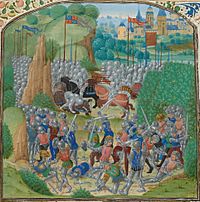
Robert's son, John, Earl of Carrick, became the most important Stewart lord in the south. Meanwhile, Alexander, Earl of Buchan, was powerful in the north. Alexander's actions, enforced by Gaelic soldiers, drew complaints from northern earls and bishops. These complaints hurt the king's standing within the Council. They led to criticism of his ability to control Buchan.
Robert's disagreements with John about how to fight the war, and his continued failure to deal with Buchan in the north, led to a big political change in November 1384. The Council took away the king's power to govern and appointed John as lieutenant of the kingdom. This was like a takeover. With Robert sidelined, there was nothing to stop the war. In June 1385, 1200 French soldiers joined the Scots in a campaign. This involved the Earl of Douglas and two of Robert's sons, John and Robert. There were small gains, but a quarrel between the French and Scottish commanders led to abandoning an attack on the important Roxburgh Castle.
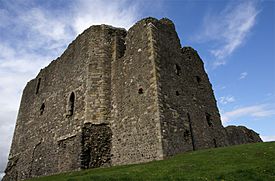
The Scottish victory over the English at the Battle of Otterburn in August 1388 led to John's fall from power. One of the Scottish casualties was John's close ally, James, Earl of Douglas. Douglas died without an heir, which led to different people claiming his title and lands. John supported one person, while his younger brother, Robert, Earl of Fife, supported another. Fife, now with his powerful Douglas ally, and those who supported the king, made a counter-move at the December Council meeting. The leadership of Scotland passed from John (who had recently been badly hurt by a horse-kick) to Fife. Many also approved of Fife's plan to properly deal with the lawlessness in the north, especially his younger brother Buchan's actions. Fife removed Buchan from his positions in the north. This role was given to Fife's son, Murdoch Stewart.
Robert II traveled through the northeast of the kingdom in late January 1390. This was perhaps to show the new political situation in the north after Buchan was removed from power. In March, Robert returned to Dundonald Castle in Ayrshire, where he died on 19 April. He was buried at Scone on 25 April.
How Historians See Robert II
Historians have looked at Robert II's reign differently over time. Earlier historians like Gordon Donaldson (1967) and Ranald Nicholson (1974) often described his reign as not very successful. Donaldson said Robert's career before and after becoming king was "undistinguished." Nicholson also said Robert's lack of governing skills led to problems within the country.
However, more recent historians like Stephen Boardman (2007), Alexander Grant (1984 & 1992), and Michael Lynch (1992) give a more balanced view of Robert II. Modern historians show that Scotland became wealthier and more stable, especially during the first ten years of his rule. Boardman explains that Robert II faced negative stories about him. David II's supporters criticized his leadership, calling it "tyranny." Later, when he was king, his son John's supporters said Robert was old and not fit to rule.
Robert II's connection to Gaelic Scotland also drew criticism. He grew up in his family lands in the west and was comfortable with the Gaelic language and culture. He had strong relationships with the Gaelic lords in the Hebrides, upper Perthshire, and Argyll. Throughout his reign, Robert spent long periods in his Gaelic homelands. Complaints in Lowland Scotland at the time seemed to suggest that the king was too involved in Gaelic matters.
Boardman also says that many negative views of Robert II come from the French writer Jean Froissart. Froissart wrote that the king "had red bleared eyes... which clearly showed that he was no valiant man, but one who would remain at home than march to the field." But early Scottish writers, like Andrew of Wyntoun and Walter Bower, saw Robert II as a Scottish hero. They described him as a defender of Scotland and the direct heir to Robert I.
Grant (1992) agrees that Robert II's reign was "not so unsuccessful" in terms of foreign and domestic policy. He suggests that the protest before Robert's coronation was not against his right to the throne. Instead, it was a demand that royal favors should not continue as they had under David II. Grant also questions how reliable Froissart's writings are for Robert II's reign.
Michael Lynch points out that Robert II's reign from 1371 until John became lieutenant in 1384 was a time of continued wealth and stability. Abbot Bower described this period as one of "tranquility, prosperity and peace." Lynch suggests that any weakening of the government happened after the 1384 takeover, not before. This takeover was rooted in Robert II favoring his third son, Alexander Stewart, Earl of Buchan (known as the Wolf of Badenoch).
Marriages and Children
In 1336, Robert first married Elizabeth Mure (who died in 1355). She was the daughter of Sir Adam Mure. Their marriage needed special permission from the Pope, which they received in 1347. So, they remarried in 1349 to make it fully official.
From this marriage, ten children grew up:
- John (died 1406), who became King of Scotland as Robert III. He married Anabella Drummond.
- Walter (died in 1363). He married Isabella MacDuff, Countess of Fife.
- Robert, Earl of Fife and later Duke of Albany (died 1420). He married Margaret Graham, Countess of Menteith in 1361, and then Muriella Keith in 1381.
- Alexander Stewart, Earl of Buchan (died 1405), known as "The Wolf of Badenoch". He married Euphemia of Ross in 1382.
- Margaret, who married John of Islay, Lord of the Isles.
- Marjorie, who married John Dunbar, Earl of Moray, and then Sir Alexander Keith.
- Elizabeth, who married Thomas de la Hay, Lord High Constable of Scotland.
- Isabel (died 1410). She married James Douglas, 2nd Earl of Douglas (died in 1388), and then John Edmonstone of that Ilk in 1389.
- Johanna (Jean), who married Sir John Keith (died 1375), then John Lyon, Lord of Glamis (died 1383), and finally Sir James Sandilands.
- Katherine, who married Sir Robert Logan of Grugar and Restalrig, Lord High Admiral of Scotland.
In 1355, Robert married his second wife, Euphemia de Ross (who died in 1387). She was the daughter of Hugh, Earl of Ross. They had four children:
- David Stewart, Earl of Strathearn, born around 1356 and died in 1389.
- Walter Stewart, Earl of Atholl, born around 1360. He was executed in Edinburgh in 1437 for being involved in the killing of King James I.
- Elizabeth, who married David Lindsay, 1st Earl of Crawford in 1380.
- Egidia, who married William Douglas of Nithsdale in 1387.
King Robert II also had several children outside of marriage with different women. These included four sons with Mariota de Cardeny:
- Alexander Stewart, of Inverlunan
- Sir John Stewart, of Cardeny
- James Stewart, of Abernethy and Kinfauna
- Walter Stewart
By Moira Leitch (according to stories):
- Sir John Stewart, Sheriff of Bute (1360 – died 1445/9), an ancestor of the Marquesses of Bute.
Other children born by unknown women:
- John Stewart, Lord of Burley (killed 1425)
- Alexander Stewart, a church official in Glasgow
- Sir Alexander Stewart of Inverlunan
- Thomas Stewart, a church official
- James Stewart of Kinfauns
- Walter Stewart
- Maria or Mary Stewart, wife of Sir John de Danielstoun.
Robert II in Stories
Robert II has been shown in historical novels. These include:
- The Three Perils of Man; or, War, women, and witchcraft (1822) by James Hogg. This story takes place during Robert II's reign, when his "country enjoyed happiness and peace." Part of the story is at Linlithgow Palace, where Robert promises to marry his daughter Margaret Stewart to the knight who can take Roxburgh Castle from the English.
- The Lords of Misrule (1976) by Nigel Tranter. This book covers events from about 1388 to 1390. It shows the last years of Robert II and how Robert III of Scotland became king. As the old king grew "feeble, weary and half-blind," his children and other nobles fought for power. Scotland became wild because of their conflicts. Robert Stewart, Duke of Albany, and Alexander Stewart, Earl of Buchan, are important characters.
- Courting Favour (2000) by Nigel Tranter. This book follows the life of John Dunbar, Earl of Moray in the courts of David II of Scotland and Robert II. John is a son-in-law to Robert II and works for him as a diplomat.
See also
 In Spanish: Roberto II de Escocia para niños
In Spanish: Roberto II de Escocia para niños


